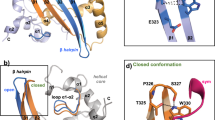Abstract
The hepatitis C virus NS3 gene encodes a RNA helicase with several sequence motifs conserved among the members of the DExH box protein family. The contributions of the sequence motifs to enzyme activity were assessed in this study by substitution of alanine for the Lys in the ATP binding motif GxGK (referred to as K1236A mutation), or for the Asp in the DExH motif (D1316A), or for the Arg in the middle of the QRxGRxGR motif known for RNA binding (R1490A). Histidine-tagged recombinant proteins of Mr 54,000 were expressed in Escherichia coli and purified by chromatography on nickel agarose. All three mutants were severely defective in ATPase and RNA helicase activities, but loss of the ATPase activity was not dependent on polynucleotide cofactors. With the exception of R1490A mutant, a stable complex was formed between dsRNA substrates and recombinant proteins, indicating that the arginine-rich motif is required for efficient RNA binding. Complex formation was not affected by omission of ATP or substitution by a non-hydrolyzable analog AMP-PCP, suggesting that neither binding nor hydrolysis of ATP is required for RNA binding. Moreover, the K1236A mutant which was defective in binding ATP exhibited an unusually strong affinity for RNA duplex. These results suggest that the conserved motifs cooperatively constitute a large functional domain rather than act as individual domains with strictly independent functions, and that alteration of one motif affects functions of other motifs in a mutually interactive fashion.
Similar content being viewed by others
References
Clarke B., J Gen Virol 78, 2397–2410, 1997.
Neddermann P., Tomei L., Steinkuhler C., Gallinari P., Tramontano A., and De Francesco R., Biol Chem 378, 469–476, 1997.
Suzich J.A., Tamura J.K., Palmer-Hill F., Warrener P., Grakoui A., Rice C.M., Feinstone S.M., and Collett M.S., J Virol 67, 6152–6158, 1993.
Jin L. and Peterson D.L., Arch Biochem Biophys 323, 47–53, 1995.
Kim D.W., Gwack Y., Han J.H., and Choe J., Biochem Biophys Res Commun 215, 160–166, 1995.
Hong Z., Ferrari E., Wright-Minogue J., Chase R., Risano C., Seelig G., Lee C.-G., and Kwong A.D., J Virol 70, 4261–4268, 1996.
Tai C.-L., Chi W.-K., Chen D.-S., and Hwang L.H., J Virol 70, 8477–8484, 1996.
Morgenstern K.A., Landro J.A., Hsiao K., Lin C., Gu Y., Su M.S.-S., and Thomson J.A., J Virol 71, 3767–3775, 1997.
Schimid S.R. and Linder P., Mol Microbiol 6, 283–292, 1992.
Fuller-Pace F.V., Trends Cell Biol 4, 271–274, 1994.
Kadare G., and Haenni A.-L., J Virol] 71, 2583–2590, 199
Pause A. and Sonenberg N., EMBO J 11, 2643–2654, 1992.
Gorbalenya A.E., Koonin E.V., Donchenko A.P., and Blinov V.M., Nucleic Acids Res 17, 4713–4730, 1989.
Linder P., Lasko P.F., Ashburner M., Leroy P., Nielsen P.J., Nishi K., Schnier J., and Slonimsky P.P., Nature 337, 121–122, 1989.
Pause A., Methot N., and Sonenberg N., Mol Cell Biol 13, 6789–6798, 1993.
Cho Y.-G., Yoon J.-W., Jang K.-L., Kim C.-M., and Sung Y.-C., Mol & Cells 3, 195–202, 1993.
Ho S.N., Hunt H.D., Horton R.M., Pullen J.K., and Pease L.R., Gene 77, 51–59, 1989.
Tamura J.K. and Gellert M., J Biol Chem 265, 21342–21349, 1990.
Lee C.-G. and Hurwitz J., J Biol Chem 267, 4398–4407, 1992.
Fernandez A., Lain S., and Garcia J.A., Nucleic Acids Res 23, 1327–1332, 1995.
Kim D.W., Kim J., Gwack Y., Han J.H., and Choe J., J Virol 71, 9400–9409, 1997.
Gross C.H. and Shuman S., J Virol 70, 1706–1713, 1996.
Yao N., Hesson T., Cable M., Hong Z., Kwong A.D., Le H.V., and Weber P.C., Nat Struct Biol 4, 463–467, 1997.
Kim J.L., Morgenstern K.A., J.P., Dwyer M.D., Thomson J.A., Murcko M.A., Lin C., and Caron P.R., Structure 6, 89–100, 1998.
Story R.M. and Steitz T.A., Nature 355, 374–376, 1992.
Gross C.H. and Shuman S., J Virol 69, 4727–4736, 1995.
Sung P., Higgins D., Prakash L., and Prakash S., EMBO J 7, 3263–3269, 1988.
Heilek G.M. and Peterson M.G., J Virol 71, 6264–6266, 1997.
Eagles R.M., Balmori-Melian E., Beck D.L., Gardner R.C., and Forster R.L.S., Eur J Biochem 224, 677–684, 1994.
Fernandez A., Guo H.S., Saenz P., Simon-Buela L., Gomez de Cedron M., and Garcia J.A., Nucleic Acids Res 25, 4474–4480, 1997.
Author information
Authors and Affiliations
Rights and permissions
About this article
Cite this article
Min, KH., Sung, YC., Choi, SY. et al. Functional Interactions between Conserved Motifs of the Hepatitis C Virus RNA Helicase Protein NS3. Virus Genes 19, 33–43 (1999). https://doi.org/10.1023/A:1008184522153
Issue Date:
DOI: https://doi.org/10.1023/A:1008184522153




